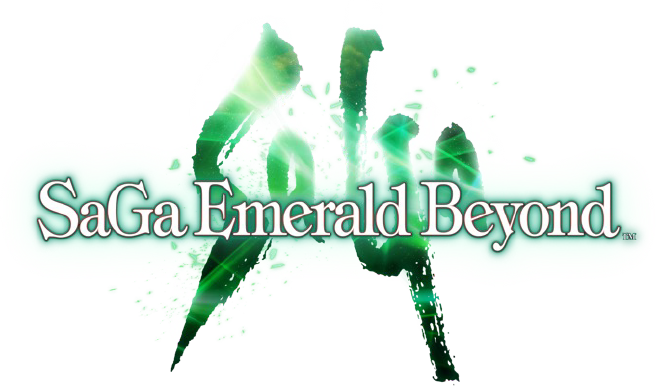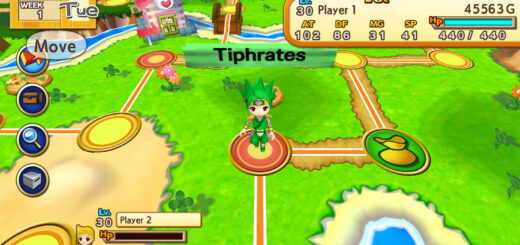SaGa Emerald Beyond Review
An Enticing SaGa
SaGa Emerald Beyond is the latest in the long-running SaGa series from Square Enix, and like its predecessors, it revels in challenging the traditional notions of how RPGs should work. Like SaGa Scarlet Graces before it, it strips down RPG exploration to its barest form, focusing on the story with choices and consequences while simultaneously featuring one of the best battle systems in JRPG history. It can be an off-putting experience at first, but when Emerald Beyond gets going, there’s almost nothing like it, even within its own series.
Like many SaGa games before it, Emerald Beyond allows the player to select from a variety of protagonists, each with their own story to pursue. These all eventually involve traversing through an array of different worlds, usually searching for some manner of MacGuffin and involving to some extent a shadowy multiversal organization. The worlds vary from fantasy realms to futuristic cities, and some even stranger ones as well. None of the stories are groundbreaking or full of much depth, but they’re entertaining at the very least and don’t overstay their welcome.
Emerald Beyond looks quite linear at first glance, as the next story points are always clearly labeled on the map. This means that there’s never any confusion on where to go next. Places that can advance the story are always present and clearly labeled, and sidequests and optional battles are marked separately. It makes progression mean and lean, truly respecting the player’s time. However, early linearity hides the game’s true nature. Story sequences will often have consequential decisions to make, and when multiple plot markers are present, offer different choices based on where the player goes. Given the multiple protagonists, the number of potential story sequences is pretty staggering.
Combat is where players will likely be spending the majority of their time in SaGa Emerald Beyond, and thankfully it is the best feature of the game. The setup is simple enough, showing turn order for the player and enemies with placement based on formation, character abilities and stats, and actions from the previous round. Players select actions for their characters, each of which will pull from a pool of points that increases as combat goes on. Different actions will move the character’s placement in the turn order, and strategy revolves around arranging characters next to each other to trigger combos while trying to disrupt enemy combos. While it may appear simple at first glance, abilities that move characters in the turn order by reacting to certain enemy or ally actions provide many different strategic options to try.
While combat can understandably feel quite daunting in harder encounters, requiring players to think carefully each round, even average encounters never feel like a cakewalk. This is a welcome change from many RPGs out there, making the majority of battles feel important and engaging. Thankfully, the game is set up so there is little to manage between encounters, as characters always start each battle alive and at full health, even during a string of fights. The only stat that needs to be kept track of is Life Points because if these run out, that character will be unusable for a few battles. These points are reset when moving from world to world so they don’t become too bothersome. However, if players get stuck in a battle, Life Points are not recovered when retrying, so repeatedly retrying a challenging battle can leave the party in a sorry state.
SaGa Emerald Beyond’s battles are fun and challenging, and thankfully it does a good job of teaching players without getting in the way of enjoyment. Each time a new type of attack is learned by or used against a party member/character, a tutorial will pop up explaining how it works. Explanations are also always available via the menus if players forget how something works. Party members come in a variety of shapes and sizes, with different abilities depending on the race of the character. New skills are learned through the classic SaGa method of “sparking”, randomly learning new skills from the weapon the character is attacking with. Though this system can be frustratingly random, a nice feature in this particular game is that “sparking” a new interrupt skill often occurs during crucial moments of encounters. It can be frustrating to not have any idea when new skills will be acquired, but characters will acquire them at a good clip, and party members are rarely lacking in offensive options.
Character management is relatively straightforward, with little need to change equipment as the game progresses. Instead, players can periodically upgrade existing gear using materials acquired through battles. Occasionally, pre-upgraded equipment will be acquired, saving time tracking down upgrade materials. Most character management will involve deciding what skills to equip on characters, as only a certain number can be brought into battle. Building the right party with the right set of skills is an important part of the game, as players will always be in search of the perfect mix of skill types. Character formations are another consideration, and the game includes a massive number of these to choose from. The benefits of each vary widely, as one may decrease skill costs the turn after a combo, whereas another might give different buffs/advantages to each character depending on their position in the formation. There are plenty of options for players to tinker with to try and find their way through the game’s more difficult challenges.
Audio and visual presentation in SaGa Emerald Beyond, in stark contrast to the amazing battle system, can be a mixed bag. World exploration is presented through small and often very simplistic maps. Though colorful and expressive enough to convey the different worlds, they feel overly simplistic. Story cutscenes suffer in a similar fashion, with little to no animation in character models as dialogue proceeds. Battle sequences are by far the best-looking element of the game. Attacks animate nicely and combos have a good amount of flare, with some fun dialogue often thrown in as well. There is a limited variety of enemy types, which can get a bit annoying as the game progresses through new and different worlds, yet players are still fighting palette-swapped slimes and dog monsters. Music in the game faces similar issues. Though the compositions are excellent and fitting for story sequences and battles, there are a limited number of tracks reused throughout the game. How much of a problem repetition will be may vary from player to player, as runs through the various character storylines vary in length and depend on choices made.
At the end of the day, SaGa Emerald Beyond takes what worked in its predecessor and improves upon it, while bringing in touches of classic SaGa at the same time. The story provides a fun if surface-level romp through a variety of worlds. With many different main characters to choose from, there’s also a wealth of replayability. With one of the best and most engaging battle systems out there, even the most seasoned RPGamers will find their skills tested. SaGa Emerald Beyond is easily one of the best and most accessible SaGa games in series history.


Engaging battle system
Story choices offer tons of replayability
Lots of party members and skills for players to tinker with
Lack of variety in monster design
Map graphics feel overly simplistic
Story sequences too similar between protagonists










Recent Comments